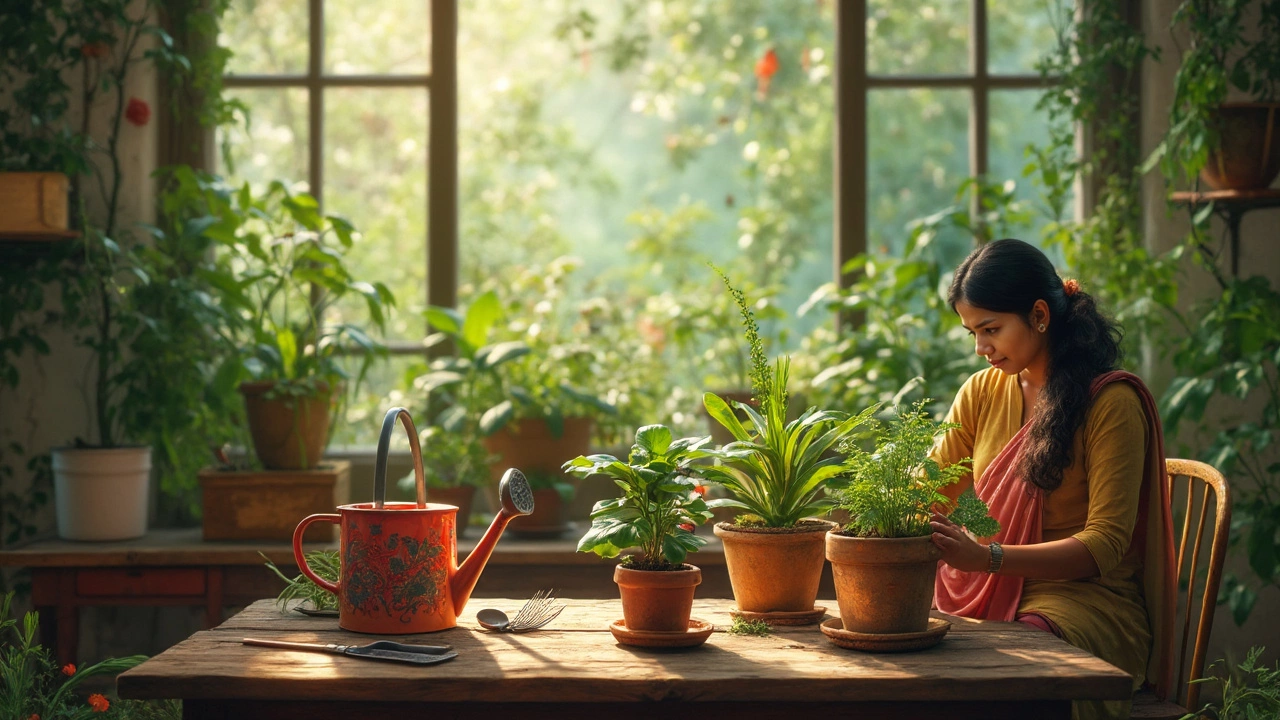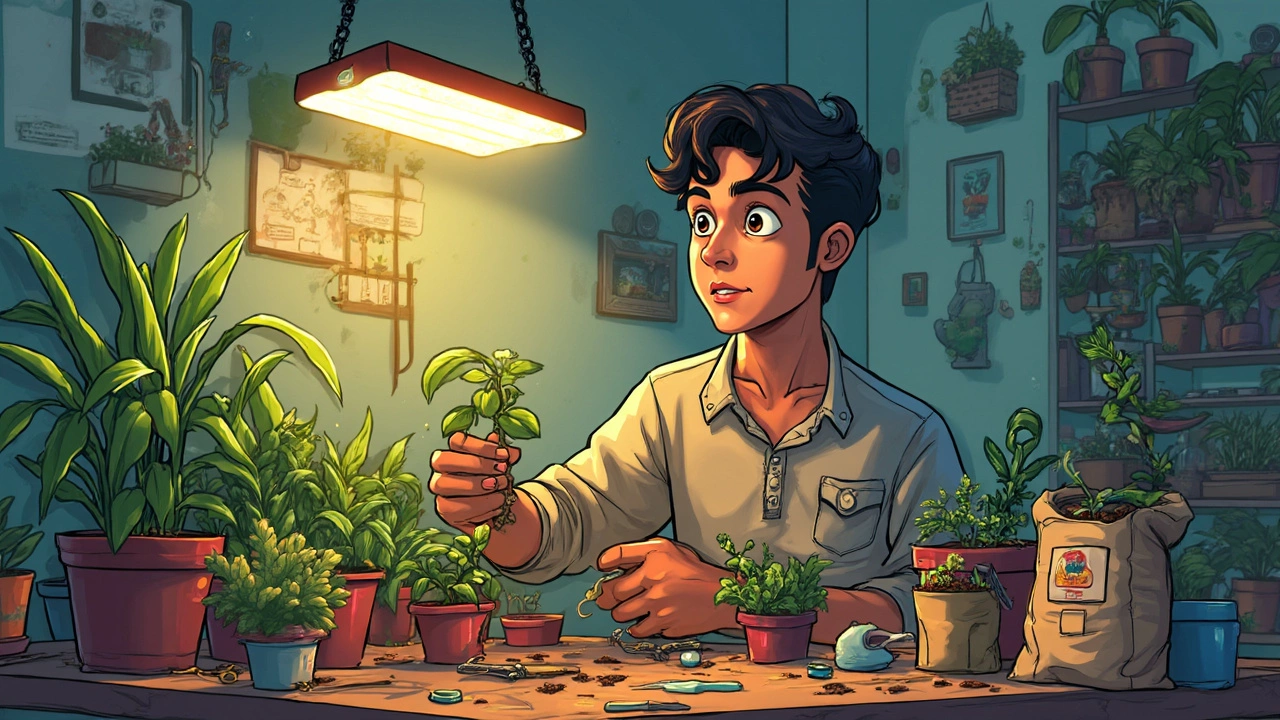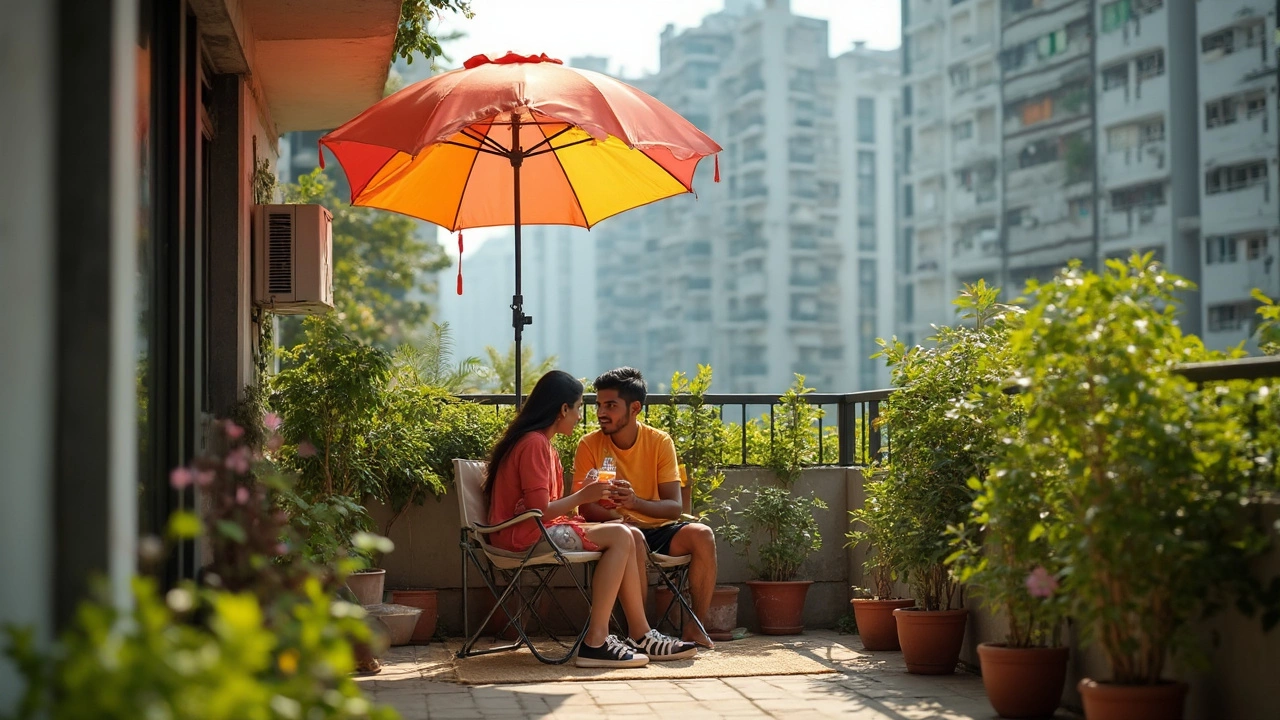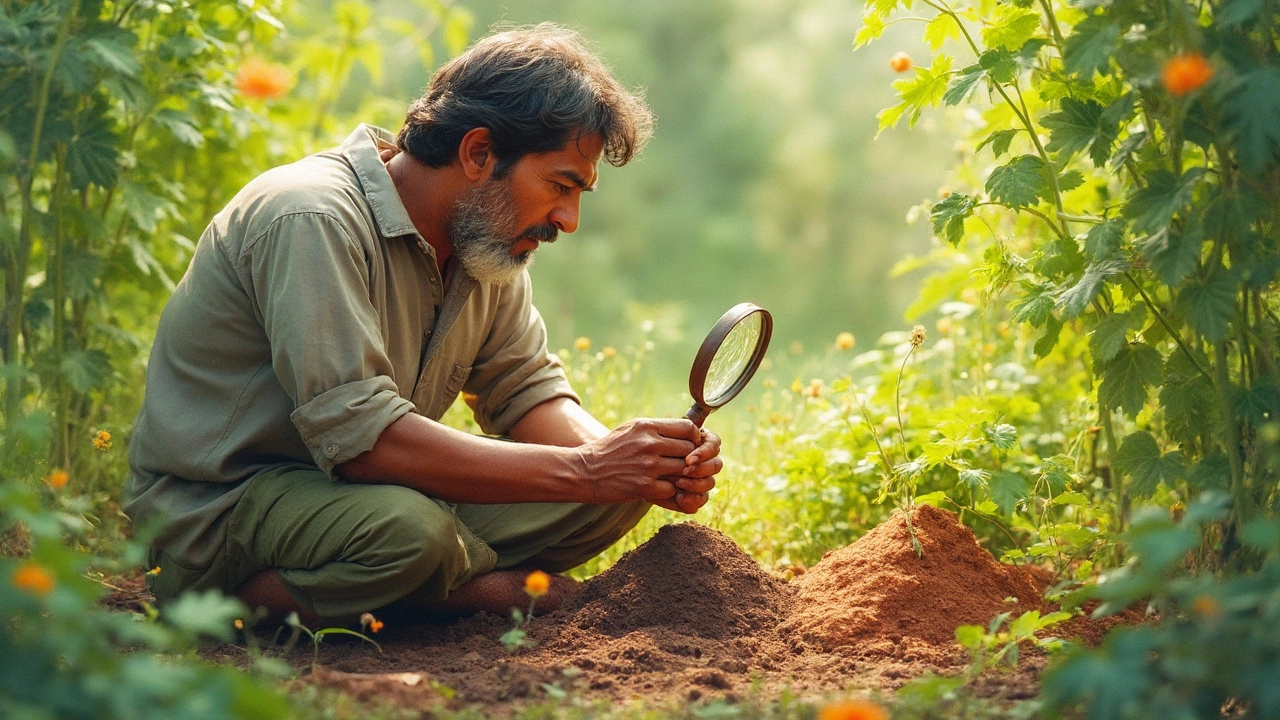Indoor Gardening Essentials: Must-Have Tools for Every Enthusiast

Starting an indoor garden? You're in for a treat. Tending to plants inside your home is like having a living, breathing art project. But what do you really need to get started? Let's start with the essentials: lighting. Indoor plants can't just rely on natural sunlight filtering through your windows. Consider investing in some quality grow lights to give your plants the full spectrum they need to thrive.
Once you've got your lighting sorted, turn your attention to watering. Overwatering is a super common rookie mistake. Instead, get a moisture meter—it'll save you from turning your pots into swamps. And speaking of pots, the right soil and a set of tools for repotting make a big difference. Remember, plants need room to grow and breathe!
- Light It Right
- Watering Wisely
- Potting and Soil Tools
- Pruning Perfection
- Fighting Pests Smartly
- Tech to Keep You on Track
Light It Right
Getting indoor gardening right starts with giving your plants the light they need. Natural sunlight is fantastic, but let's be real—not everyone's got the luxury of endless sunny windows. That's where grow lights come into play. They're your plants' best friends, especially when long winter months reduce daylight hours.
Understanding Grow Light Options
There are several types of grow lights, and choosing the right one can make all the difference:
- LED Lights: These are energy-efficient and last a long time. Perfect if you're all about sustainability.
- Fluorescent Lights: Great for beginners, especially T5 lights that offer full spectrum lighting.
- Incandescent and Halogen Lights: These are older tech, so we don't recommend them due to higher energy use and less spectrum control.
Positioning Your Lights
Proper placement is key. Keep the lights close to the plants, usually within 6 to 12 inches, depending on the light type. Too close, and you might toast the leaves; too far, and your plants may stretch for light.
Choosing the Right Spectrum
Different light colors can affect growth stages. For leafy growth, blue light is best, while red light promotes flowering. Many indoor gardening tools include lights that adapt their spectrum for the plant's needs—these are super handy!
Light Duration
Plants need around 12 to 16 hours of light daily. Use a timer to keep your lighting schedule consistent. Trust me; it'll save you from the hassle of manually switching lights on and off.
| Type | Color Spectrum | Average Lifespan |
|---|---|---|
| LED | Full-Spectrum | 50,000 hours |
| Fluorescent | Cool and Warm | 20,000 hours |
Gear up with the right indoor gardening tools and watch your green friends flourish right before your eyes. Light's not just about helping them survive; it's about making them thrive!
Watering Wisely
For indoor gardeners, getting watering just right is like finding the sweet spot in a Goldilocks tale—not too much, not too little, but just perfect. Overwatering is one of the most common pitfalls, leading to wilting and root rot. To avoid this, using a moisture meter is a game-changer. It tells you exactly when your plants need a drink, saving you from guessing games.
The Right Tools for the Right Balance
If you're new to the indoor gardening scene, consider starting with self-watering pots. These pots offer a built-in reservoir system, ensuring your plants get a consistent water supply even if you occasionally forget. Pair this with a good watering can—one that offers a gentle shower, not a torrential downpour—and you're all set.
When and How Often?
Knowing when to water can be tricky, as it often depends on several factors, like the size of your plants, the season, and their placement in your home. Smaller pots generally dry out faster, while plants in bright light might need more frequent watering. A good tip is to check your plant's soil by poking a finger an inch deep; if it's dry, time to water.
Top Tips to Avoid Overwatering
- Use pots with drainage holes—they're your first line of defense against soggy soil.
- Cut back on watering during the winter months, as plants typically need less in the cooler, darker days.
- Group plants with similar watering needs together—this helps in maintaining consistency.
Water Quality Matters
Tap water is fine for most plants, but it sometimes contains minerals that can build up in the soil over time. Consider using distilled or rainwater, especially if you notice white crusts forming on the soil surface. These subtle choices can ensure your indoor plants remain healthy and lush.
| Plant Type | Water Frequency |
|---|---|
| Succulents | Every 2-3 weeks |
| Tropical plants | Once a week |
| Ferns | Twice a week |
Potting and Soil Tools
Alright, let's dig into dirt. When it comes to creating the perfect home for your plants, your choice of pot and soil needs to be spot on. First up, pots. You might be tempted by those cute pots in the store, but pay attention to drainage. Without proper drainage, roots can get swamped, leading to root rot. Trust me, nothing says 'unhappy plant' like soggy roots!
Now, when we're talking soil, not all dirt is created equal. You need to match the soil type to your plant's specific needs. Most indoor gardening tools sets will include a spade and hand trowel, which are perfect for mixing and transferring soil. For succulents, go for gritty, well-draining soil, while ferns prefer something more moist and rich in organic matter.
Choosing the Right Soil Mix
There are loads of premade soil mixes out there, or you can mix your own if you're feeling adventurous. If you're buying premade, check the labels for components like peat moss, perlite, and vermiculite. These ingredients keep the soil fluffy and well-aerated.
| Plant Type | Ideal Soil Composition |
|---|---|
| Succulents | Sand, Perlite |
| Ferns | Peat Moss, Vermiculite |
| Herbs | Loamy, Well-draining |
An essential tool not to skip is the scoop. Anything from an old yogurt container to a fancy stainless steel scoop can save you from messy spills while potting. And finally, gloves. You may love the feel of soil on your hands, but your skin won't love any surprises like thorns or spiky roots.
- Use pots with good drainage.
- Match soil type to each plant.
- Keep a hand trowel and scoop handy.
- Choose the right premade mix or DIY your own.
With the right essential gardening equipment, you'll master the art of potting and see those little green friends of yours thrive.

Pruning Perfection
If you want your indoor garden to look its best, pruning is key. It’s not just about appearance; it’s about keeping your plants healthy. Proper pruning encourages growth and helps prevent disease. But how do you get it right?
Understanding the Basics
First things first: know when to prune. For most indoor plants, a good rule of thumb is to prune during their growing season, which is usually spring and summer. Pruning in these months can give your plants an energy boost.
Tools of the Trade
When diving into indoor gardening, quality tools are a must. A sturdy pair of pruning shears should be at the top of your best garden tools list. They’re perfect for trimming dead leaves and stems. If you have smaller plants or delicate ones like succulents, consider using a pair of sharp scissors for a bit more precision.
Step-by-Step Pruning
- Inspect your plant to identify dead or overgrown parts.
- Start by snipping away any dead or yellowing leaves. This helps prevent the spread of disease.
- Trim any overgrown branches or stems that disturb the plant's shape.
- Make your cuts at a 45-degree angle to help your plant heal faster.
Don’t overdo it! It's easy to get carried away. Remove no more than 1/3 of the plant at once to keep it healthy.
Benefits of Regular Pruning
Don’t underestimate how much pruning can boost plant health. It helps with airflow, reducing the risk of fungal infections. Plus, you’ll guide your plant to grow in a way that complements your space.
| Plant Type | Pruning Frequency |
|---|---|
| Fiddle Leaf Fig | Every 6 months |
| Spider Plant | Monthly |
| Monstera | Bimonthly |
Fighting Pests Smartly
Okay, so you've set up your indoor oasis. But guess who else loves warm, cozy spots with lush plants? Yup, pests. Battling these little invaders might not have been what you signed up for, but with a smart approach, you can keep them at bay and protect your precious greenery.
Identify Common Culprits
First things first, know who you're up against. Common indoor garden pests include spider mites, aphids, and fungus gnats. Each of them has its own telltale signs. For example, yellowing leaves could indicate aphids, while tiny webs might mean spider mites are calling your plant home.
Natural Deterrents
Chemical pesticides might be a last resort, but there are plenty of natural ways to send pests packing. Neem oil is a fantastic option—it disrupts insects’ growth and reproduction when applied regularly. You can also make your own insecticidal soap using simple ingredients like dish soap and water. Apply it to your plants and watch pests disappear.
Preventive Measures
Prevention is always better than cure. Maintain good airflow around your plants and avoid water-logged soil, as many pests thrive in moist environments. Implement regular inspections to catch any pest problems early on.
Tools That Help
Want to take it up a notch? Introduce some sticky traps. These can help catch flying insects before they find a place to lay eggs. Plus, a magnifying glass can be handy for spotting those tiny pests that are otherwise tough to see.
If you're exploring indoor gardening tools, adding pest control tools to your arsenal can be crucial for maintaining plant health. A well-maintained garden not only looks great but also grows better.
Tech to Keep You on Track
These days, tech isn't just for your phone or computer—your indoor garden can benefit from it too! Using technology can simplify your gardening routine and help your plants flourish.
Smart Timers and Plugs
One of the easiest ways to improve your indoor gardening is by utilizing smart plugs and timers. They can automate your grow lights, turning them on and off based on your settings. All you need is a simple app on your smartphone. This way, even if you're not home, your plants won't miss out on their vital light cycles.
Plant Care Apps
Ever forgotten when you last watered your plants? Plant care apps can track watering schedules, remind you when to fertilize, and even let you log new growth. Many of these apps come with tonnes of advice on different plant species, making them great for beginners and seasoned gardeners alike.
Climate Control Devices
The right humidity and temperature are crucial for indoor plants care. Smart humidifiers or thermostats can help maintain ideal conditions, notifying you when changes are needed. Keeping your indoor climate stable can really help your garden thrive.
Environmental Sensors
Consider getting sensors that monitor soil moisture, temperature, and light levels. Some even connect to your Wi-Fi and send data straight to your phone, providing insights into the health of your garden. Staying in tune with your plant's needs is easier than ever.
Here's a table with some popular tech tools:
| Tool | Purpose |
|---|---|
| Smart Plug | Automates power usage |
| Plant App | Tracks plant care |
| Humidity Sensor | Monitors air moisture levels |
| Soil Monitor | Checks soil conditions |
Integrating tech tools into your indoor garden doesn't just make life easier, it supports healthier plants. So, why not give your indoor gardening tools a tech upgrade?





